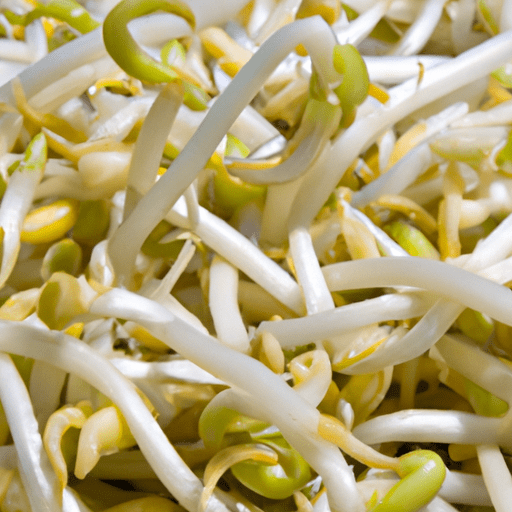The Radiant Crunch of Mung Bean Sprouts: A Closer Look
As we explore the vast realm of culinary wonders, there are a select few ingredients that manage to captivate both our palates and imaginations. The humble mung bean sprout is certainly one of them. With its crisp texture, delicate flavor, and notable versatility, these sprouts have become a beloved addition to countless dishes around the world. Let’s dive deeper into the delightful world of mung bean sprouts and discover why they should have a special place in your kitchen.
A Taste Sensation:
Mung bean sprouts possess a mild, slightly nutty flavor that pairs effortlessly with an array of ingredients. Their pleasant crunch and subtly sweet taste make them a delightful addition to salads, stir-fries, and soups. They bring a refreshing element to dishes, adding texture and a hint of earthiness, without overpowering the overall flavor profile.
Culinary Uses:
The versatility of mung bean sprouts knows no bounds. In Asian cuisine, they frequently star in classic dishes such as pad thai, bibimbap, and spring rolls, where they contribute a delightful crunch. These sprouts are also exceptional when lightly sautéed or stir-fried, retaining their crispness while absorbing the flavors of accompanying ingredients. Whether added to refreshing summer rolls, slathered in a tangy dressing for salads, or tucked into comforting noodle soups, mung bean sprouts bring vibrancy and a satisfying crunch to any dish they grace.
Nutritional Powerhouse:
Beyond their culinary value, mung bean sprouts offer an abundance of nutrients. They are low in calories and fat while providing a notable dose of vitamins and minerals. These sprouts are particularly rich in vitamin C, essential for immune function and collagen production. Additionally, they offer a good amount of vitamin K, which plays a key role in bone health. Mung bean sprouts also provide dietary fiber, aiding in digestion and promoting a healthy gut. Adding these nutritious sprouts to your meals is an excellent way to enhance both flavor and nourishment.
A Story to Tell:
Dating back thousands of years, mung beans have been a staple ingredient in Asian cuisine and traditional medicine. According to ancient Chinese texts, mung beans were believed to possess cooling properties and were used to balance the body’s energy. Additionally, mung beans are renowned for their sprouting capabilities, providing a source of sustenance throughout history. Today, mung bean sprouts are embraced by various culinary traditions and have gained popularity worldwide.
Fun Fact:
Did you know that mung bean sprouts are a key ingredient in the iconic Korean dish, “ssukgae-tteok”? This delightful treat consists of mung bean sprout pancakes that are not only delicious but also symbolize the arrival of spring.
In conclusion, mung bean sprouts are a culinary gem, offering a delightful texture, gentle flavor, and an array of nutritional benefits. Their versatility makes them an ideal choice for various dishes, adding a touch of freshness and crunch. So the next time you’re at the market, don’t miss the opportunity to bring home a bag of these radiant sprouts and elevate your cooking to new heights.
Mung Bean Sprouts
Origin: Mung bean sprouts, also known as green gram sprouts or moong sprouts, are sprouts that come from the mung bean (Vigna radiata). The mung bean is native to the Indian subcontinent and is widely cultivated in various countries across Asia.
Common Uses: Mung bean sprouts are commonly used in Asian cuisine, particularly in dishes from China, Korea, and Southeast Asia. They are often utilized raw in salads, stir-fries, spring rolls, and sandwiches. They can also be cooked and added to soups, curries, or noodle dishes.
Nutritional Benefits: Mung bean sprouts are low in calories and rich in nutrients. They are a good source of vitamin C, vitamin K, and folate. They also provide minerals like potassium and manganese. Additionally, mung bean sprouts are a good source of fiber and contain a decent amount of protein.
Unique Properties: Mung bean sprouts are known for their crunchy texture and slightly sweet, nutty flavor. They have a pale yellowish color with a thin, tender stalk and small, rounded leaves. These sprouts are notable for their quick growth; they typically sprout in just a few days when soaked in water and placed in a warm environment.
Historical Significance: Mung bean sprouts have a long history of consumption and cultivation in Asia. They are believed to have been initially domesticated in India around 1500 BCE. Due to their high availability and nutritional value, mung bean sprouts have been an essential part of the Asian diet for centuries, both as a staple ingredient and a medicinal plant. They are also commonly used in traditional Chinese medicine for their numerous health benefits.




Use the share button below if you liked it.
It makes me smile, when I see it.